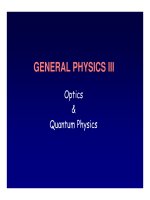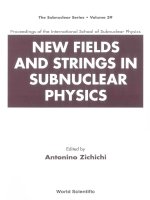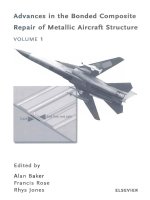- Trang chủ >>
- Khoa Học Tự Nhiên >>
- Vật lý
Advances in nuclear physics v 23 negele j w , vogt e
Bạn đang xem bản rút gọn của tài liệu. Xem và tải ngay bản đầy đủ của tài liệu tại đây (4.56 MB, 315 trang )
ADVANCES IN
NUCLEAR PHYSICS
VOLUME 23
CONTRIBUTORS TO THIS VOLUME
Matthias Burkardt
Institute for Nuclear Theory
University of Washington
Seattle, Washington
Permanent Address: Department of Physics
New Mexico State University
Las Cruces, New Mexico
James J. Kelly
Department of Physics
University of Maryland
College Park, Maryland
A Continuation Order Plan is available for this series. A continuation order will bring delivery of
each new volume immediately upon publication. Volumes are billed only upon actual shipment.
For further information please contact the publisher.
ADVANCES IN
NUCLEAR PHYSICS
Edited by
J.W. Negele
Center for Theoretical Physics
Massachusetts Institute of Technology
Cambridge, Massachusetts
Erich Vogt
Department of Physics
University of British Columbia
Vancouver, B.C., Canada
VOLUME 23
KLUWERACADEMIC PUBLISHERS
NEW YORK, BOSTON, DORDRECHT, LONDON, MOSCOW
eBookISBN:0-306-47067-5
Print ISBN:0-306-45220-0
©2002 Kluwer Academic Publishers
New York, Boston, Dordrecht, London, Moscow
All rights reserved
No part of this eBook may be reproduced or transmitted in any form or by any means, electronic,
mechanical, recording, or otherwise, without written consent from the Publisher
Created in the United States of America
Visit Kluwer Online at:
and Kluwer's eBookstore at:
ARTICLES PUBLISHED IN EARLIER VOLUMES
Volume 1
The Reorientation Effect • J. de Boer and J. Eichler
The Nuclear SU
3
Model • M. Harvey
The Hartree-Fock Theory of Deformed Light Nuclei • G. Ripka
The Statistical Theory of Nuclear Reactions • E. Vogt
Three-Particle Scattering—A Review of Recent Work on the Nonrelativistic Theory • I. Duck
Volume 2
The Giant Dipole Resonance • B. M. Spicer
Polarization Phenomena in Nuclear Reactions • C. Glashausser and J. Thirion
The Pairing-Plus-Quadrupole Model • D. R. Bes and R. A. Sorensen
The Nuclear Potential • P. Signell
Muonic Atoms • S. Devons and I. Duerdoth
Volume 3
The Nuclear Three-Body Problem • A. N. Mitra
The Interactions of Pions with Nuclei • D. S. Koltun
Complex Spectroscopy • J. B. French, E. C. Halbert, J. B. McGrory, and S. S. M. Wong
Single Nucleon Transfer in Deformed Nuclei • B. Elbeck and P. O.
Isocalar Transition Rates in Nuclei from the Reaction • A. M. Bernstein
Volume 4
The Investigation of Hole States in Nuclei by Means of Knockout and Other Reactions •
Daphne F. Jackson
High-Energy Scattering from Nuclei • Wieslaw Czyz
Nucleosynthesis and Neutron-Capture Cross Sections • B. J. Allen, J. H. Gibbons, and
R. L. Macklin
Nuclear Structure Studies in the Z = 50 Region • Elizabeth Urey Baranger
An s-d Shell-Model Study for A = 18 – 22 • E. C. Halbert, J. B. McGrory, B. H. Wildenthal,
and S. P. Pandya
Volume 5
Variational Techniques in the Nuclear Three-Body Problem • L. M. Delves
Nuclear Matter Calculations • Donald W. L. Sprung
Clustering in Light Nuclei • Akito Arima, Hisashi Horiuchi, Kuniharu Kubodera, and
Noburu Takigawa
V
vi Articles Published in Earlier Volumes
Volume 6
Nuclear Fission • A. Michaudon
The Microscopic Theory of Nuclear Effective Interactions and Operators • Bruce R. Barrett
and Michael W. Kirson
Two-Neutron Transfer Reactions and the Pairing Model • Ricardo Broglia, Ole Hansen, and
Claus Riedel
Volume 7
Nucleon-Nucleus Collisions and Intermediate Structure • Aram Mekjian
Coulomb Mixing Effects in Nuclei: A Survey Based on Sum Rules • A. M. Lane and
A. Z. Mekjian
The Beta Strength Function • P. G. Hansen
Gamma-Ray Strength Functions •
G.
A. Bartholemew, E. D. Earle, A. J. Ferguson,
J. W. Knowles, and M. A. Lone
Volume 8
Strong Interactions in -Hypernuclei • A. Gal
Off-Shell Behavior of the Nucleon-Nucleon Interaction • M. K. Strivastava and
D. W. L. Sprung
Theoretical and Experimental Determination of Nuclear Charge Distributions • J. L. Friar and
J. W. Negele
Volume 9
One- and Two-Nucleon Transfer Reactions with Heavy Ions • Sidney Kahana and A. J. Baltz
Computational Methods for Shell-Model Calculations • R. R. Whitehead, A. Watt, B. J. Cole,
and I. Morrison
Radiative Pion Capture in Nuclei • Helmut W. Baer, Kenneth M. Crowe, and Peter Truöl
Volume 10
Phenomena in Fast Rotating Heavy Nuclei • R. M. Lieder and H. Ryde
Valence and Doorway Mechanisms in Resonance Neutron Capture • B. J. Allen and
A. R. de L. Musgrove
Lifetime Measurements of Excited Nuclear Levels by Doppler-Shift Methods •
T. K. Alexander and J. S. Forster
Volume 11
Clustering Phenomena and High-Energy Reactions • V. G. Neudatchin, Yu. F. Smirnov, and
N. F. Golovanova
Pion Production in Proton-Nucleus Collisions • B. Holstad
Fourteen Years of Self-Consistent Field Calculations: What Has Been Learned • J. P. Svenne
Hartree-Fock-Bogoliubov Theory with Applications to Nuclei • Alan L. Goodman
Hamiltonian Field Theory for Systems of Nucleons and Mesons • Mark Bolsterli
Articles Published in Earlier Volumes vii
Volume 12
Hypernetted-Chain Theory of Matter at Zero Temperature • J. G. Zabolitzky
Nuclear Transition Density Determinations from Inelastic Electron Scattering •
Jochen Heisenberg
High-Energy Proton Scattering • Stephen J. Wallace
Volume 13
Chiral Symmetry and the Bag Model: A New Starting Point for Nuclear Physics •
A. W. Thomas
The Interacting Boson Model • A. Arima and F. Iachella
High-Energy Nuclear Collisions • S. Nagamiya and M. Gyullasy
Volume 14
Single-Particle Properties of Nuclei Through Reactions • Salvatore Frullani and
Jean Mougey
Volume 15
Analytic Insights into Intermediate-Energy Hadron-Nucleus Scattering • R. D. Amado
Recent Developments in Quasi-Free Nucleon Scattering • P. Kitching, W. J. McDonald,
Th. A. J. Maris, and C. A. Z. Vasconcellos
Energetic Particle Emission in Nuclear Reactions • David H. Boal
Volume 16
The Relativistic Nuclear Many-Body Problem • Brian D. Serot and John Dirk Walecka
Volume 17
P-Matrix Methods in Hadronic Scattering • B. L. G. Bakker and P. J. Mulders
Dibaryon Resonances • M. P. Locher, M. E. Saino, and A.
Skyrmions in Nuclear Physics • Ulf-G. Meissner and Ismail Zahed
Microscopic Description of Nucleus-Nucleus Collisions • Karlheinz Langanke and
Harald Friedrich
Volume 18
Nuclear Magnetic Properties and Gamow-Teller Transitions • A. Arima, K. Shimizu, W. Bentz,
and H. Hyuga
Advances in Intermediate-Energy Physics with Polarized Deuterons • J. Arvieux and
J. M. Cameron
Interaction and the Quest for Baryonium • C. Amsler
Radiative Muon Capture and the Weak Pseudoscalar Coupling in Nuclei • M. Gmitro and
P. Truöl
Introduction to the Weak and Hypoweak Interactions • T. Goldman
viii Articles Published in Earlier Volumes
Volume 19
Experimental Methods for Studying Nuclear Density Distributions • C. J. Batty, H. J. Gils, and
H. Rebel
The Meson Theory of Nuclear Forces and Nuclear Structure • R. Machleidt
Volume 20
Single-Particle Motion in Nuclei •
C
. Mahaux and R. Sartor
Relativistic Hamiltonian Dynamics in Nuclear and Particle Physics • B. D. Keister and
W. N. Polyzou
Volume 21
Multiquark Systems in Hadronic Physics • B. L. G. Bakker and I. M. Narodetskii
The Third Generation of Nuclear Physics with the Microscopic Cluster Model •
Karlheinz Langanke
The Fermion Dynamical Symmetry Model • Cheng-Li Wu, Da Hsuan Feng, and Mike Guidry
Volume 22
Nucleon Models • Dan Olof Riska
Aspects of Electromagnetic Nuclear Physics and Electroweak Interactions •
T. W. Donnelly
Color Transparency and Cross-Section Fluctuations in Hadronic Collisions • Gordon Baym
Many-Body Methods at Finite Temperature • D. Vautherin
Nucleosynthesis in the Big Bang and in the Stars • K. Langanke and C. A. Barnes
ARTICLES PLANNED FOR FUTURE VOLUMES
Pion–Nucleus Scattering and Isobar Propagation in Nuclei • F. Lenz and E. J. Moniz
Charge Exchange Reactions at Intermediate Energy • P. Alford and B. Spicer
The Structure of Nucleons and Pions in Electromagnetic Interactions • H. W. Fearing,
J. H. Koch, and S. Scherer
Nonperturbative Flavor and Spin Structure of the Nucleon as Seen in Deep Inelastic Scattering
• J. Speth and A. Thomas
ix
PREFACE
This volume of Advances in Nuclear Physics addresses two very different
frontiers of contemporary nuclear physics — one highly theoretical and the
other solidly phenomenological.
The first article by Matthias Burkardt provides a pedagogical overview of
the timely topic of light front quantization. Although introduced decades ago
by Dirac, light front quantization has been a central focus in theoretical nu-
clear and particle physics in recent years for two major reasons. The first, as
discussed in detail by Burkardt, is that light-cone coordinates are the natural
coordinates for describing high-energy scattering. The wealth of data in recent
years on nucleon and nucleus structure functions from high-energy lepton and
hadron scattering thus provides a strong impetus for understanding QCD on
the light cone. Second, as theorists have explored light front quantization, a
host of deep and intriguing theoretical questions have arisen associated with
the triviality of the vacuum, the role of zero modes, rotational invariance, and
renormalization. These issues are so compelling that they are now intensively
investigated on their own merit, independent of the particular application to
high-energy scattering. This article provides an excellent introduction and
overview of the motivation from high-energy scattering, an accessible de-
scription of the basic ideas, an insightful discussion of the open problems,
and a helpful guide to the specialized literature. It is an ideal opportunity for
those with a spectator’s acquaintance to develop a deeper understanding of
this important field.
The second article provides a comprehensive review by James Kelly of
major advances in the field of electron-induced nucleon knockout reactions.
In principle, knockout of a nucleon by the known electromagnetic current
provides a powerful tool to explore the energy and momentum distribution
of protons and neutrons in finite nuclei. The advent of high duty-factor ac-
celerators, polarized beams, out-of-plane detectors, and increased kinematic
range and resolution has dramatically expanded our experimental horizons,
and brings us far closer to exploiting the full potential of this probe. Kelly’s
xi
xii Preface
article provides a thorough review of the basic framework for extracting nu-
clear structure information from knockout reactions and surveys major new
experimental results. It is also extremely useful in highlighting the limitations
in our understanding of these reactions arising from theoretical uncertainties
in the optical potential, off-shell nucleon currents, and the reaction mecha-
nism. The combination of the recent experiments reviewed here and those
about to begin at new facilities represents a major advance in nuclear physics,
and this article provides both an excellent introduction for nonspecialists and
a comprehensive overview for those in the field.
J. W. N
EGELE
E. W. VOGT
CONTENTS
Chapter 1
LIGHT FRONT QUANTIZATION
Matthias Burkardt
1. Introduction 1
1.1. Deep Inelastic Scattering 1
1.2. Advantages of Light-Front Coordinates
4
1.3. Outline
6
2. Canonical Quantization
7
2.1. Quantization in Light-Front Coordinates
7
2.2.
Coordinates
on
Finite Light-Front Intervals
10
2.3. Examples for Canonical Light-Front Hamiltonians
12
3. The Light-Front Vacuum
19
3.1. The Physical Picture
19
3.2. Examples for Zero Modes . . . . . . . .
21
3.3.
Zero
Modes
and the
Vacuum
in
Coordinates
27
3.4.
Vacuum Condensates
and Sum
Rules
37
4. Perturbative Renormalization
39
4.1. Scalar Fields
41
4.2. Fermions
44
4.3. Gauge Theories
48
4.4. Summary 49
5. Nonperturbative Calculations 49
5.1. Discrete Light-Cone Quantization 49
5.2. Functional Integration on a Longitudinal Lattice 53
xiii
xiv Contents
5.3. Hamiltonian Monte Carlo on a Transverse Lattice . . . . 54
5.4.
Light-Front Tamm–Dancoff
59
6. Summary, Conclusions, and Outlook 62
7. Appendix: The Dirac–Bergmann Formalism 65
References 70
Chapter 2
NUCLEON KNOCKOUT BY INTERMEDIATE ENERGY
ELECTRONS
James J. Kelly
1. Introduction 75
2.
One-Photon-Exchange Approximation 78
2.1. Definition of the Response Tensors for . . . .
78
2.2. Basic Response Functions for Electron Scattering 82
2.3. Electron Polarization 88
2.4. Response Functions for Recoil Polarization 90
2.5. Recoil Polarization Observables 97
2.6.
Target Polarization
99
2.7.
Basic
PWIA
for
101
2.8. Kinematical Conventions
102
2.9.
Electron
Scattering
from
a
Moving
Nucleon
104
3. Nucleon Form Factors
106
3.1. Sachs Form Factors
106
3.2. Unpolarized Measurements of Nucleon Form Factors . . .
110
3.3.
Polarized Measurements of Nucleon Form Factors
.
120
3.4.
Summary
128
4.
Proton
Knockout
Experiments
on
Few-Body
Systems
129
4.1. The Reaction
131
4.2. The Reaction
135
4.3. The Reaction
137
5.
Distorted
Wave
Analysis
of
Reactions
139
5.1.
Distorted Wave Amplitude
139
Contents xv
5.2. Distorted Momentum Distributions 142
5.3. Bound State Wave Functions 142
5.4. Ejectile Distortion
144
5.5. Nonrelativistic Models of the Nuclear Current 172
5.6. Electron Distortion 188
5.7. Relativistic Distorted Wave Models 192
5.8. Summary 194
6.
Spectral Functions
from
on
Complex Nuclei
195
6.1.
Definition
of the
Spectral Function
.
1
96
6.2. Dispersive Optical Models 206
6.3. Quasiparticle Hamiltonian Model 210
6.4. Distorted Momentum Distribution 212
6.5.
Experimental Definition of Distorted Momentum Distributions
214
6.6. Distorted Momentum Distributions for Valence Orbitals . .
216
6.7.
Ejectile-Energy Dependence of Missing Momentum
Distributions
223
6.8.
Occupation Probabilities
225
6.9.
High Momentum Components
229
6.10. Summary . . .
236
7. Studies of the Reaction Mechanism for Nucleon Knockout . . . 238
7.1.
Enhancement of
239
7.2. The Swollen Nucleon Hypothesis 248
7.3. Interference Response Functions for Complex Nuclei . .
249
7.4. Meson Exchange and Isobar Currents 251
7.5.
Channel Coupling in Reactions 262
7.6. Evidence for Multinucleon Knockout 272
7.7. Summary 280
8. Conclusions 282
References 285
Index
295
ADVANCES IN
NUCLEAR PHYSICS
VOLUME 23
Chapter 1
LIGHT FRONT QUANTIZATION
Matthias Burkardt
Institute for Nuclear Theory
University of Washington
Seattle, Washington 98195-1550
1. Introduction 1
2. Canonical Quantization 7
3. The Light-Front Vacuum
19
4. Perturbative Renormalization
39
5. Nonperturbative Calculations 49
6. Summary, Conclusions, and Outlook
62
7. Appendix: The Dirac–Bergmann Formalism 65
References
70
1. INTRODUCTION
1.1. Deep Inelastic Scattering
More than twenty years after quantum chromodynamics (QCD) was in-
troduced as a microscopic theory of strong interactions, very little is known
about its solutions. At least in principle, it should be possible to describe the
interaction of nucleons with external probes using quark and gluon degrees
Permanent address: Department of Physics, New Mexico State University, Las Cruces, New
Mexico 88003-0001.
Advances in Nuclear Physics, Vol. 23, edited by J. W. Negele and E. W. Vogt. Plenum Press,
New York, ©1996.
1
2 Matthias Burkardt
of freedom on the basis of QCD. So far, however, the extreme complexity of
this theory has slowed any progress in this direction considerably.
Deep inelastic lepton–nucleon scattering (DIS) provides access to quark and
gluon degrees of freedom in nucleons and nuclei. In these experiments one
shoots high energy leptons (e.g., electrons) at a hadronic target (usually protons
or nuclei) and measures the energy and momentum transfer to the target by de-
tecting the final state lepton (Fig. 1.1). The hadronic final state X is not mea-
sured (usually the nucleon is destroyed in these reactions and the hadronic fi-
nal state consists of many particles). Because of the extremely large momentum
transfer to the target (typical momentum transfers in DIS experiments are sev-
eral or more), the inclusive cross sections are dominated by single particle
response functions along the light cone. To illustrate this let us use the optical
theorem which relates the differential lepton nucleon cross section to the imag-
inary part of the forward Compton amplitude
(1)
(Fig. 1.2). One finds
where
E
and are the energies of the initial and final lepton,
the four momentum transfer of the lepton on the target and
is the leptonic tensor. The hadronic tensor
(S is the spin of the target proton) contains all the information about the
parton substructure of the target proton.
In the Bjorken limit
fixed), deep inelastic structure functions exhibit Bjorken scaling: up to kinemat-
Light Front Quantization 3
ical coefficients, the hadronic tensor (1.2) depends only on but no longer on
Q
2
(within perturbatively calculable logarithmic corrections). In order to under-
stand this result, it is convenient to introduce light-front variables
so that the scalar product reads
Furthermore let us choose a frame where The
Bjorken limit corresponds to and fixed, while Bjorken scaling
is equivalent to the statement that the structure functions become independent of
q
+
in this limit (again up to trivial kinematic coefficients). In this limit, the inte-
grand in Eq. (1.2) contains the rapidly oscillating factor exp which kills
all contributions to the integral except those where the integrand is singular.
(2)
Due to causality, the integrand must vanish for and the
current product is singular at = 0. The leading singularity can be
obtained from the operator product expansion by contracting two fermion oper-
ators in the product yielding
a nonlocal term bilinear in the fermion field multiplying a free (asymptotic free-
dom!) fermion propagator from 0 to x which gives rise to the above-mentioned
singularity structure.
(3)
The dominance in the integral has two
consequences. First it explains Bjorken scaling, because q
+
enters the hadronic
tensor only via the term in the exponent and for dependence
drops out. Second, and this is very important for practical calculations, the par-
ton distributions, i.e., the Bjorken scaled structure functions, can be expressed
in terms of correlation functions along the light-front space direction For
example, for the spin averaged parton distribution one obtains
4 Matthias Burkardt
The physical origin of this result can be understood as follows. Consider
again the virtual forward Compton amplitude (Fig. 1.2). In principle, the pho-
tons in the first and second interaction in Fig. 1.2 can couple to the same as well
as to different quarks in the target. However, the hadronic wave function can
only absorb momenta which are of the order of the QCD-scale
MeV). Therefore, in the limit of large momentum transfer, only such diagrams
survive where the two photons in Fig. 1.2 couple to the same quark. All other
diagrams have large momenta flowing through the wave function or they in-
volve extra hard gluon exchanges which results in their suppression at large Q
2
.
The large momentum transfer is also important because of asymptotic freedom.
Since the running coupling constant of QCD
goes to zero for large Q
2
, all interactions of the struck quark can be neglected and
it propagates essentially without interaction between the two photon-vertices.
Furthermore, since the momentum transfer is much larger than the masses of the
quarks in the target, the struck quarks propagation between becomes ultrarela-
tivistic, i.e., it moves exceedingly close to the light cone x
2
= 0. Due to the
high-energy nature of the scattering, the relativistic structure function is a LF
correlation.
(4,5)
Already at this point it should be clear that LF coordinates play
a distinguished role in the analysis of DIS experiments—a point which will be-
come much more obvious after we have introduced some of the formal ideas of
LF quantization.
1.2. Advantages of Light-Front Coordinates
LF quantization is very similar to canonical equal time (ET) quantization
(6)
(here we closely follow Ref. 7). Both are hamiltonian formulations of field the-
ory, where one specifies the fields on a particular initial surface. The evolution
of the fields off the initial surface is determined by the Lagrangian equations of
motion. The main difference is the choice of the initial surface, for ET
and for the LF, respectively. In both frameworks states are expanded in
terms of fields (and their derivatives) on this surface. Therefore, the same phys-
ical state may have very different wave functions* in the ET and LF approaches
because fields at provide a different basis for expanding a state than
fields at The reason is that the microscopic degrees of freedom—field
amplitudes at versus field amplitudes at —are in general quite
different from each other in the two formalisms.
This has important consequences for the practical calculation of parton dis-
tributions (1.3) which are real time response functions in the equal time formal-
ism.
†
In order to evaluate Eq. (1.3) one needs to know not only the ground state
*By “wave function” we mean here the collection of all Fock space amplitudes.
†
The arguments of and in Eq. (1.3) have different time components!
Light Front Quantization 5
wave function of the target, but also matrix elements to excited states. In con-
trast, in the framework of LF quantization, parton distributions are correlation
functions at equal LF time i.e., within the initial surface and can
thus be expressed directly in terms of ground state wave functions. (As a re-
minder: ET wave functions and LF wave functions are in general different ob-
jects.) In the LF framework, parton distributions can be easily calculated
and have a very simple physical interpretation as single particle momentum den-
sities, where measures the fraction of momentum carried by the hadron*
Although DIS is probably the most prominent example for practical applica-
tions of LF coordinates, they prove useful in many other places as well. For ex-
ample, LF coordinates have been used in the context current algebra sum rules in
particle physics.
(8)
Another prominent example is form factors, where moments
of the wave function along the LF determine the asymptotic falloff at large mo-
mentum transfer.
(9)
More recently, LF quantization found applications in inclu-
sive decays of heavy quarks.
(10–12)
From the purely theoretical point of view, various advantages of LF quanti-
zation derive from properties of the ten generators of the Poincaré group (trans-
lations rotations and boosts Those generators which leave the ini-
tial surface invariant and for ET, and and for LF) are “sim-
ple” in the sense that they have very simple representations in terms of the fields
(typically just sums of single particle operators). The other generators, which
include the “hamiltonians” which is conjugate to in ET and which
is conjugate to the LF time in LF quantization) contain interactions among
the fields and are typically very complicated. Generators which leave the ini-
tial surface invariant are also called kinematic generators, while the others are
called dynamic generators. Obviously it is advantageous to have as many of the
ten generators kinematic as possible. There are seven kinematic generators on
the LF but only six in ET quantization.
The fact that the generator of translations, is kinematic (obviously
it leaves invariant!) and positive has striking consequences for the
LF vacuum.
(7)
For free fields implies for the LF energy
Hence positive energy excitations have positive After
the usual reinterpretation of the negative energy states this implies that
*In DIS with nonrelativistic kinematics (e.g., thermal neutron scattering off liquid
4
He) one also
observes scaling and the structure functions can be expressed in terms of single particle response
functions. However, due to the different kinematics, nonrelativistic structure functions at large
momentum transfer are dominated by Fourier transforms of equal time response functions, i.e.,
ordinary momentum distributions.
6 Matthias Burkardt
for a single particle is positive [which makes sense, considering that
being kinematic means that it is given by the sum of
single particle Combined with the positivity of this implies that the
Fock vacuum (no particle excitations) is the unique state with All
other states have positive Hence, even in the presence of interactions,
the LF Fock vacuum does not mix with any other state and is therefore an
exact eigenstate of the LF hamiltonian (which commutes with If
one further assumes parity invariance of the ground state, this implies that
the Fock vacuum must be the exact ground state of the fully interacting LF
quantum field theory.* In sharp contrast to other formulations of field theory,
the LF vacuum is trivial! This implies a tremendous technical advantage but
also raises the question whether nonperturbative LF-field theory is equivalent
to conventional field theory, where nonperturbative effects usually result in a
highly nontrivial vacuum structure. This very deep issue will be discussed in
more detail in Section 3.
Dirac was the first who had the idea to formulate field theory in LF
coordinates
(6)
(see also Ref. 13).
†
In this remarkable work (almost 20 years
before scaling was discovered in deep inelastic lepton nucleon scattering!) he
has shown that it should in principle be possible to formulate a consistent
quantum theory on the LF. This work laid the basis for all further develop-
ments, but left many details open. The main issues are the structure of the
vacuum, renormalization, and practical algorithms for solution.
1.3. Outline
There are many similarities between the formal steps in ET quantization
and LF quantization. In Section 2 we will explain the basic steps in construct-
ing LF hamiltonians and give examples for scalar fields, fermions, and gauge
fields. The vacuum on the LF is very controversial. On the one hand simple
kinematical arguments seem to show that in LF field theory the vacuum of
interacting field theories is the same as the free field theory vacuum (all inter-
actions turned off). In QCD we know that chiral symmetry is spontaneously
broken. It is up to now unclear whether a LF hamiltonian, with its trivial
vacuum, is capable of describing this physics. We will elaborate on this point
in Section 3. Renormalization is an issue because the LF approach to field
theory is not manifestly covariant. Thus UV divergences (which occur on
the LF as they do everywhere in quantum field theory) are not necessarily
*Practical calculations show that typical LF hamiltonians are either unbounded from below or
their ground state is indeed the Fock vacuum.
†
Later, a similar framework was developed independently on the basis of a Lorentz frame (“the
infinite momentum frame”) that moves with
Light Front Quantization 7
the same for all Lorentz components of a particular operator under consider-
ation. Clearly this requires a more complex counterterm structure to render
the theory finite and to restore Lorentz invariance for physical observables
(see Section 4). Despite certain technical simplifications, field theory on the
LF is a priori still an enormously complex many body problem. In particu-
lar, in QCD one knows from DIS experiments that the nucleon consists not
only of the three valence quarks, but that sea quark pairs and gluons are a
significant, if not dominant, component of the nucleon’s LF wave function,
i.e., one should not expect that the LF wave functions of ground state hadrons
in QCD are simple. Recent attempts to cast LF bound state problems into a
form that can be solved on a computer will be described in Section 5.
2. CANONICAL QUANTIZATION
2.1. Quantization in Light-Front Coordinates
In this chapter, the formal steps for quantization on the light front are
presented. For pedagogical reasons this will be done by comparing with
conventional quantization (with as “time”). On the one hand this shows
that the basic steps in the quantization procedure in LF and in ET formalism
are in fact very similar. More importantly, however, we will thus be able to
highlight the essential differences between these two approaches to quantum
field theory more easily.
In the context of canonical quantization one usually starts from the action
where After selecting a time direction one forms the
momenta which are canonically conjugate to
and postulates canonical commutation relations between fields and corre-
sponding momenta at equal “time” (Table 2.l).
†
In the next step one constructs the Hamilton operator and the other com-
ponents of the momentum vector. Thus one has completely specified the
†
The canonical quantization procedure in the ET formulation can, for example, be found in Ref.
19. The rules for canonical LF quantization have been taken from Refs. 20 and 21.
* Here may stand for ordinary time as well as for LF time or any
other (not space-like) direction.
8 Matthias Burkardt
Light Front Quantization 9
dynamics and can start solving the equations of motion. Typically, one ei-
ther makes some variational ansatz or a Fock space expansion. In the latter
approach one writes the hadron wave function as a sum over components
with a fixed number of elementary quanta (for example, in QCD:
etc.). The expansion coefficients, i.e., the wave functions for the cor-
responding Fock space sector, are used as variational parameters. They are
determined by making the expectation value of the energy stationary with
respect to variations in the wave function. Typically the variation is done for
fixed momentum.* This whole procedure results in coupled integral equations
for the Fock space components. In general they have to be solved numeri-
cally. In practical calculations, since one cannot include infinitely many Fock
components, one has to introduce some ad hoc cutoff in the Fock space. Thus
it is very important to demonstrate that physical observables do not depend
on how many Fock components are included.
Until one selects the canonically conjugate momenta and postulates equal
commutation relations, i.e., at the level of the classical Lagrangian, the
transition from ET to the LF consists of a mere rewriting. After quantization,
the independent degrees of freedom consist of the fields and their conjugate
momenta on the initial surface for ET and for LF). Thus
different degrees of freedom are employed to expand physical states in the
ET and in the LF approach. Of course, after solving the equations of motion,
physical observables must not depend on the choice of quantization plane.
However, it may turn out that one approach is more efficient (e.g., faster
numerical convergence) than the other, or more elegant and more easy to
interpret physically. In general, this will of course depend on the details of
the interaction. An extreme example is In the ET
approach
(22–24)
one first has to solve coupled, nonlinear integral equations
with a singular kernel to obtain the Hartree–Fock solution for the vacuum.
Then, in order to calculate meson masses, one has to solve the two-body
equation in this background, which amounts to solving another set of coupled
(linear) integral equations with singular kernel. In the LF approach
(25,26)
all
one has to do is solve one linear integral equation with singular kernel. The
numerical results for the meson spectrum are in extremely good agreement
between the two approaches, but numerically the LF calculation is more than
one order of magnitude faster! In this case the simplification arises because
the LF vacuum is trivial — a point which will be elaborated in more detail
below as well as in Section 3.
Which approach is preferable may, however, also depend on the observ-
*On the LF this is very important because i.e., unrestricted variation (P_ allowed
to vary) results in









